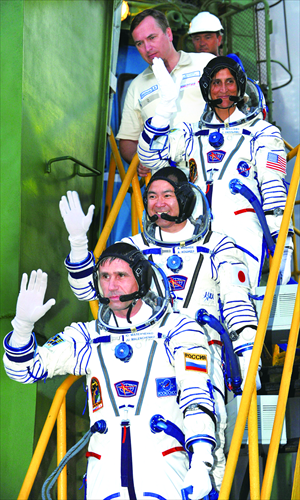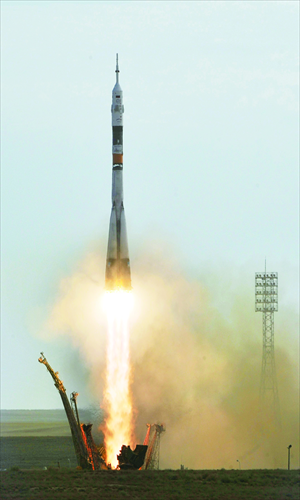Russian rocket blasts off for space station
Source:AFP Published: 2012-7-15 23:35:03

Astronauts Yuri Malenchenko (lower) of Russia, Sunita Williams (top) of the US and Akihiko Hoshide (center) of Japan wave before boarding the Soyuz TMA-05M spacecraft at the Baikonur cosmodrome on Sunday. Photo: AFP


The Soyuz TMA-05M spacecraft blasts off from the Russian-leased Kazakh Baikonur Cosmodrome on Sunday. Photo: AFP
A Soyuz rocket blasted off with an international crew of three toward the International Space Station (ISS) on Sunday in a mission testing the reliability of Russia's crisis-prone space program.
NASA's Sunita Williams, Japan's Akihiko Hoshide and Yury Malenchenko of Russia started their journey on top of the Soyuz-FG under the open skies of the Kazakh steppe on schedule and without a hitch.
The trio gave big thumbs up after the needle-shaped craft pierced a thin layering of white clouds and safely reached orbit about nine minutes later.
"Goodbye Planet Earth for now! Woo Hoo!" Williams tweeted a few hours before the 305-ton craft shook the ground with a violent orange explosion of booster rocket flames.
Russia's Roscosmos space program chief Vladimir Popovkin told reporters that he spoke briefly to the crew members a few minutes into their journey and "They feel fine. I have no doubts that everything will go well."
Live footage from inside the Soyuz TMA-05M capsule that will dock to the ISS after a two-day journey showed a small doll in a red dress hanging before the three space travelers as a good luck charm as the rocket gathered pace.
The astronauts read calmly through thick printouts of their crew procedures while mission commander Malenchenko picked at some of the more distant controls on the panel with a black stick in his hand.
"That is one of the more low-tech aspects of the Soyuz spacecraft," the NASA flight commentator said in a live video feed. "Some of those buttons are a little bit far away from the crew members so that stick makes it a little easier for him to access the controls."
The workhorse of Russian spaceflight - briefly grounded last year amid a spate of launch accidents affecting cargo craft and satellites - today represents the world's last human link to the international science lab.
The final launch of a US satellite in July 2011 left nations dependent on the reliability of Russia's Soviet-era space achievements while governments and private companies scramble for new ways to launch humans to the station and beyond.
Russia's underfunded Roscosmos agency meanwhile has been hit by turmoil that saw several changes in leadership and bickering with other segments of the space program - particularly those responsible for updating the Soyuz.
Roscosmos had earlier this year released a somewhat vague mission statement through 2030 that emphasized new voyages to the Moon and the further scientific exploration of Mars while downplaying human spaceflight.
It also placed a short-term emphasis on purchasing foreign technology that could help bring Russia up to par with the US.
AFP
A Soyuz rocket blasted off with an international crew of three toward the International Space Station (ISS) on Sunday in a mission testing the reliability of Russia's crisis-prone space program.
NASA's Sunita Williams, Japan's Akihiko Hoshide and Yury Malenchenko of Russia started their journey on top of the Soyuz-FG under the open skies of the Kazakh steppe on schedule and without a hitch.
The trio gave big thumbs up after the needle-shaped craft pierced a thin layering of white clouds and safely reached orbit about nine minutes later.
"Goodbye Planet Earth for now! Woo Hoo!" Williams tweeted a few hours before the 305-ton craft shook the ground with a violent orange explosion of booster rocket flames.
Russia's Roscosmos space program chief Vladimir Popovkin told reporters that he spoke briefly to the crew members a few minutes into their journey and "They feel fine. I have no doubts that everything will go well."
Live footage from inside the Soyuz TMA-05M capsule that will dock to the ISS after a two-day journey showed a small doll in a red dress hanging before the three space travelers as a good luck charm as the rocket gathered pace.
The astronauts read calmly through thick printouts of their crew procedures while mission commander Malenchenko picked at some of the more distant controls on the panel with a black stick in his hand.
"That is one of the more low-tech aspects of the Soyuz spacecraft," the NASA flight commentator said in a live video feed. "Some of those buttons are a little bit far away from the crew members so that stick makes it a little easier for him to access the controls."
The workhorse of Russian spaceflight - briefly grounded last year amid a spate of launch accidents affecting cargo craft and satellites - today represents the world's last human link to the international science lab.
The final launch of a US satellite in July 2011 left nations dependent on the reliability of Russia's Soviet-era space achievements while governments and private companies scramble for new ways to launch humans to the station and beyond.
Russia's underfunded Roscosmos agency meanwhile has been hit by turmoil that saw several changes in leadership and bickering with other segments of the space program - particularly those responsible for updating the Soyuz.
Roscosmos had earlier this year released a somewhat vague mission statement through 2030 that emphasized new voyages to the Moon and the further scientific exploration of Mars while downplaying human spaceflight.
It also placed a short-term emphasis on purchasing foreign technology that could help bring Russia up to par with the US.
AFP
Posted in: Europe, Air & Space